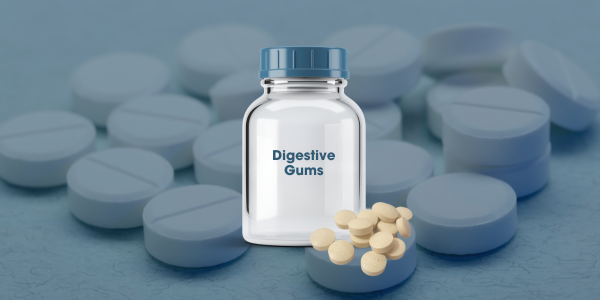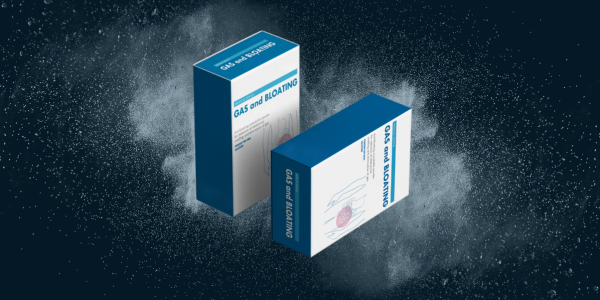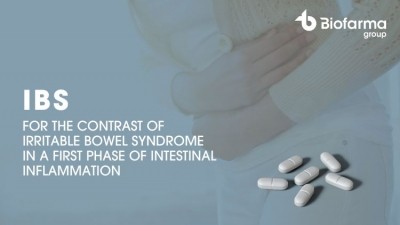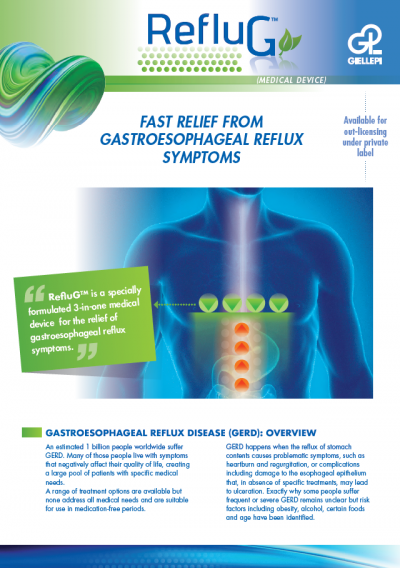Promotional Features
A new food supplement and medical device to counteract the effects of dyspepsia
Dyspepsia is the medical term used for digestive disease.
It is a condition whose prevalence is difficult to establish with certainty due to the different definitions used to describe it and the difficulty for patients to identify its exact symptoms. In fact, according to data from various studies conducted on different populations globally, the prevalence of dyspepsia varies between 7% and 45%.1
Although dyspepsia is a non-life-threatening condition, its impact on patients and health services has proved considerable. A survey conducted among several European and North American populations revealed the following: 20% of adults and children with dyspeptic symptoms said they had consulted general practitioners or hospital specialists; more than 50% of dyspeptic sufferers took medication most of the time; and about 30% of dyspeptics reported taking days off work or school because of symptoms. Similar findings have been reported by other leading researchers in this field, who have also highlighted that people with dyspepsia have a significantly reduced quality of life compared to the general population.1
Dyspepsia: Causes and symptoms
The term dyspepsia refers to the presence in a subject of digestive problems and, specifically, it refers to an often-recurring sensation of pain or discomfort in the upper portions of the abdomen.
It is also important to note that the term comprises two different forms of the condition: organic and functional dyspepsia. In the first case, dyspepsia is the consequence of an established cause, such as a disease of the digestive tract, drug intake, substance abuse or imbalances resulting from prolonged unbalanced diets.
Functional dyspepsia, on the other hand, is when the causes are not identified, and this is the condition that occurs in most cases. It is generally believed that the onset of the condition in this case is associated with a combination of visceral hypersensitivity, gastric motor dysfunction and psychological factors.
Due to the concomitance of dyspepsia with other diseases, it is not easy to identify the specific symptoms of the condition. In addition to pain and a burning sensation in the stomach, patients sometimes report bloating, nausea, vomiting and belching.
In order to counteract these symptoms, the adoption of a healthy lifestyle and, specifically, a healthy diet is generally recommended. Furthermore, several studies have associated the presence of dyspepsia with mood-related issues, thus making mental wellbeing an important ally in counteracting the condition.
Support in combating the symptoms can also be provided by two products developed by Biofarma Group: the food supplement Digestive Gum and the medical device Gas and Bloating.
Digestive Gum: A chewable tablet remedy for digestive discomfort
The symptoms of dyspepsia can have a significant impact on the quality of life of people suffering from it. This is why Biofarma Group has formulated a food supplement to counteract the effects of poor digestion in a practical pharmaceutical form: the chewable tablet.
This innovative technology contains a synergistic mix of active ingredients whose efficacy against dyspepsia is supported by scientific evidence.
The food supplement contains ginger extract titrated in gingerol and lemon peel essential oil.
Ginger extract has proven therapeutic efficacy for the stomach as it can stimulate digestion, dissolve fats and, above all, relieve nausea and vomiting. In fact, this component has been used since antiquity as a traditional remedy for gastrointestinal disorders. Its effectiveness is made possible in particular by its active ingredients, namely gingerol and shogaol.
Several preclinical and clinical studies have evaluated ginger as an effective and safe treatment for nausea and vomiting, even in sensitive contexts such as pregnancy and for chemotherapy-induced nausea and vomiting.2
For this formulation, encapsulated ginger is used in order to attenuate its strong flavour and serves to adapt the product to the tastes of a wider audience. The flavour of the tablet is also enriched by the presence of essential lemon peel oil, which not only provides a pleasant refreshing taste, but also aids digestion and helps to combat abdominal bloating.
In addition to the ingredients in the formulation, the delivery form selected for the product also provides important support in facing the symptoms of dyspepsia. Chewable tablet after a meal can help to stimulate the release of bile, digestive enzymes and acids, all components required to digest food properly, and can help avoid indigestion after a large meal by helping to calm acid reflux.3
In addition, considering the correlation between emotional wellbeing and dyspepsia, it is also important to mention the results of a number of studies showing evidence of the relaxing and calming effect of a chewable tablet. This has been analysed in laboratory, in epidemiological studies and in real-life interventions.4
If a chewable tablet can reduce feelings of stress, it can be argued that it can also help to alleviate depression, a stress-related disorder. In a clinical sample of patients with mild-to-moderate depression, depression was reduced to a greater extent when chewing gum was administered together with antidepressants, compared to taking medication alone.
Although there remain several questions that require fundamental research, the long-term benefits of chewing on mental wellbeing suggest that it could be a simple and cost-effective way to reduce stress and improve the quality of life and wellbeing of those who suffer from it.4,5
The digestive chewable tablet is a cutting-edge nutraceutical product that combines innovative technology and active ingredients, supported by science: a convenient chewable form that provides significant health benefits beyond the pleasure of chewing.
Gas and Bloating: Counteracting digestive difficulties with a medical device
Many of the symptoms associated with poor digestion which have a major impact on the quality of life of the sufferer (such as flatulence, meteorism, belching, bloating and abdominal cramps) result from an excessive accumulation of gas in the gastro-intestinal tract.
To counteract this, Biofarma Group has conceived a medical device for the treatment of these exact symptoms: Gas and Bloating.
The product is in the form of an orally-dispersible powder for oral administration, packaged in single-dose sachets of 2 grams each. Its main ingredients are simethicone and digestive enzymes.
Simethicone is an antifoaming agent that has the ability to lower the surface tension at the interface between liquid and air and to form a thin film that covers the air bubbles retained at the gastrointestinal level. In this way, the bubbles in the digestive tract are broken up, forming free gas that is then easily eliminated.
Meanwhile, digestive enzymes improve the digestion of food, counteracting the effects of possible malabsorption and consequently alleviating the symptoms associated with overproduction of gastrointestinal gas. The formulation of the medical sevice also includes excipients necessary to obtain an orodispersible powder that is pleasant in taste and safe to use. Specifically, these are substances with diluting, anti-agglomerating, flavouring and sweetening activities.
The medical device is available in two different dosages:
- Simethicone 75 mg/bag, enzymes (where present) 65 mg/bag
- Simethicone 125 mg/bag, enzymes (where present) 97.5 mg/bag
In addition, two different flavours are available for each of the formulations: chocolate flavouring and citrus flavouring. The intention is to supply the product to different distributors while taking into account the needs of the various markets for which the product is intended.
The therapeutic efficacy of the medical device was proven through an in vitro test carried out by Biofarma that observed the product's ability to degrade four substrates commonly found in food: starch, lactose, casein and a mix of triglycerides. The results of the study confirmed the effectiveness of the medical device in supporting the digestion of foods typical of a complete diet.
Gas and Bloating is therefore an important ally for individuals suffering from symptoms caused by digestive difficulties.
References
1. Sanjiv Mahadeva, Khean-Lee Goh. Epidemiology of functional dyspepsia: A global perspective. World J Gastroenterol. 2006 May 7; 12(17): 2661–2666.
2. Lete I, Allué J. The Effectiveness of Ginger in the Prevention of Nausea and Vomiting during Pregnancy and Chemotherapy. Integr Med Insights. 2016 Mar 31; 11:11-7. doi: 10.4137/IMI.S36273. PMID: 27053918; PMCID: PMC4818021.
3. Hochner H, Tenfelde SM, Abu Ahmad W, Liebergall-Wischnitzer M. Gum chewing and gastrointestinal function following caesarean delivery: a systematic review and meta-analysis. J Clin Nurs. 2015 Jul;24(13-14):1795-804. doi: 10.1111/jocn.12836. Epub 2015 Apr 7. PMID: 25850885.
4. Smith AP. Chewing gum and stress reduction. J Clin Transl Res. 2016 Apr 24;2(2):52-54. PMID: 30873461; PMCID: PMC6410656.
5. Hollingworth HL. Chewing as a technique of relaxation. Science. 1939 Oct 27;90(2339):385-7. doi: 10.1126/science.90.2339.385. PMID: 17776097.








